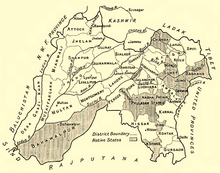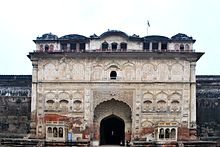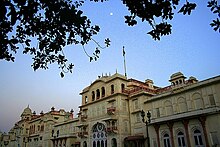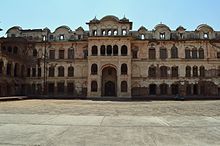Patiala State
| Patiala State ਪਟਿਆਲਾ | |||||||
|---|---|---|---|---|---|---|---|
| Princely State of British India | |||||||
| 1763–1948 | |||||||
 Patiala State in a 1911 map of Punjab | |||||||
| Population | |||||||
• 1931 | 1,625,000 | ||||||
| History | |||||||
• Established | 1763 | ||||||
| 1948 | |||||||
| |||||||
| Today part of | Punjab Haryana | ||||||
This article incorporates text from a publication now in the public domain: Chisholm, Hugh, ed. (1911). Encyclopædia Britannica (11th ed.). Cambridge University Press. {{cite encyclopedia}}: Missing or empty |title= (help) | |||||||
Patiala State was a self-governing princely state outside British India during the British Raj period in the Indian sub-continent. Patiala was one of the Phulkian States.
When the British left India in 1947, they abandoned their subsidiary alliances with the princely states, and the Maharajah of Patiala acceded to the new Union of India.
History

Patiala state was established in 171 by Baba Ala Singh, a Jat Sikh chieftain, who laid the foundation of the Patiala fort known as Qila Mubarak, around 'which the present city of Patiala is built. After the Third Battle of Panipat in 1761 in which the Marathas were defeated by the Afghans, the writ of the Afghans prevailed throughout Punjab. It is at this stage that the rulers of Patiala began to acquire ensigns of royalty. The Patiala state saw more than forty years of ceaseless power struggle with the Afghan Durrani Empire, Maratha Empire and the Sikh Empire of Lahore. In 1808, the Raja of Patiala entered into a treaty with the British against Ranjit Singh of Lahore in 1808, thus becoming collaborator in the grand empire building process by the British in, the sub-continent of India. Patiala became a 17-guns salute state during the British Raj. The rulers of Patiala such as Karam Singh, Narinder Singh, Mahendra Singh, Rajinder Singh, Bhupinder Singh and Yadvindra Singh were treated with respect and dignity by the British.
The city of Patiala was designed and developed according to a plan akin to that of temple architecture, the first settlers of Patiala were the Hindus of Sirhind, who opened their business establishments outside the Darshani Gate.[1]
The royal house is now headed by His Highness Maharajadhiraj Captain Amarinder Singh, Mahendra Bahadur of Patiala who also served as the Chief Minister of Punjab from 2002 to 2007. The royals are considered cultural and political icons in Patiala.
Maharaja Karam Singh who ruled from 1813 to 1845 (the Sikh Kingdom of Patiala in Punjab) joined the British East India Company and helped the British during the First Anglo Sikh wars against the Sikh Empire of Maharajah Ranjit Singh of Punjab which was larger and extended from Tibet Kashmir, plains of Punjab to Peshawar near the Afghan borders.
Brief history

The family claims descent from the Bhatti founder of Jaisalmer, Jaisal. His third son Rai Hem, left the family domains after the usual quarrel and carved out a small principality for himself around Bhatinda and Bhatner. His successor in the fourth degree, Khiwa, fell on hard times ad was forced to move to Kot Ladwa, where he married a girl from the Jat Basehra caste, against the clan traditions of the Rajputs. Thereafter many quarrels ensued between his descendants at the Bhattis. The Mughals appointed his descendant Mehraj in 1526. This office became hereditary amongst his descendants until Phul, the Sikh ancestor of the dynasty, which came to rule over Patiala, Jind and Nabha.
Early history
The history of Patiala state starts off with the ancestor of the Sikh Patiala Royal House, Mohan Singh being harassed by neighbouring Bhullars and Dhaliwals farmers . They would not allow Mohan to settle there. He was a follower of Guru Hargobind Sahib and the Guru appealed on behalf of Mohan but to no avail. The result was an armed struggle and the Bhullars and Dhaliwals were defeated by the Guru's men, which allowed Mohan to establish the Village of Meharaj in 1627.[2]
Battle of Mehraj
Mohan fought against the Mughals at the Battle of Mehraj 1631 on the side of Guru Hargobind Sahib.[citation needed] Mohan and his eldest son Rup Chand were later killed in a fight against the Bhatti's (a tribe who also claim to be the descendants of Rawal Jaisal of Jaisalmer, but also an enemy of the Phulkians ). Kala, Mohan's younger son succeeded the "chaudriyat", and was guardian to Rup Chand's sons Phul and Sandali.
Phul
When Kala died, Phul formed his own village (Phul), five miles from Meharaj (under the blessings of Sikh Guru's) in 1663. Nabha and Jind trace their ancestry to the devout Sikh Phul. It was one of the first Sikh Kingdoms of Punjab to be formed. Apparently the appellation of dynasty "Phulkian" is derived from their common founder. One of his sons, Chota Ram, was baptised and blessed by Guru Gobind Singh. His son Ala Singh assumed the leadership in 1714 when Banda Bahadur was engaged in the fierce battle against the Mughals. A man with vision and courage, Ala Singh's general, Gurbaksh Singh Kaleka, carved out an independent principality from a Zamindari of 30 villages. Under his successors, it expanded into a large state, touching the Shivaliks in north, Rajasthan in the south and upper courses of the Yamuna and Sutlej rivers while confronting the most trying and challenging circumstances.
Baba Ala Singh
In the middle of the eighteenth century, Baba Ala Singh, unlike many of his contemporaries, displayed tremendous shrewdness in dealing with the Marathas and Afghans, and successfully established a state which he had started building up from its nucleus Barnala. He became traitor to the Sikhs, who made him a Sardar from a peasant and fought on the side of Ahmad Shah Abdali against the Sikhs .
Qila Mubarak

In 1763 Baba Ala Singh laid the foundation of the Patiala fort known as Qila Mubarak, around which the present city of Patiala developed. After the Third Battle of Panipat in 1761 in which the Marathas were defeated, the writ of the Afghans prevailed throughout Punjab. It is at this stage that the rulers of Patiala began to acquire ensigns of royalty. Ahmad Shah Abdali bestowed upon Ala Singh furm and banner, and the title of Maharaja of Patiala. After his death, his grandson Amar Singh succeeded and received the title of Raja-I-Rajaan. He was also allowed to strike coins.
Treaty with the British
After forty years of ceaseless struggle with the Marathas and Afghans, the borders of the Patiala state witnessed the blazing trails of Ranjit Singh in the north and of the British in the east. Bestowed with the grit and instinct of survival, making self-preservation a priority the Raja of Patiala entered into a treaty with the British against Ranjit Singh in 1808, thus becoming collaborators in the empire building process of the British in the sub-continent of India. The subsequent rulers of Patiala, such as Karam Singh, Narinder Singh, Mahendra Singh, Rajinder Singh, Bhupinder Singh, and Yadvindra Singh were parties to a subsidiary alliance and were heavily influenced by the British, but retained the internal government of their state.
Maharaja Bhupinder Singh

Maharaja Bhupinder Singh, who reigned from 1900 to 1938, gave Patiala a prominent place on the political map of India and also in the field of international sports. In the game of Polo, Patiala had the World's best Polo Back, General Chanda Singh, who later went on to play for England and Spain on the requests of King Edward VII and King Alfonso of Spain, winning both Kings a prestigious Polo Cup. The Maharaja was also fond of dogs, and he and the Maharaja Ranbir Singh of Jind were equally interested in a range of dog breeds. His son Maharaja Yadavindra Singh was the first Indian prince to sign the Instrument of Accession to the new Union of India, thus facilitating the process of national integration after the Partition of India and the departure of the British in August 1947. In recognition of his services, he was appointed as Rajpramukh of the newly established Patiala and East Punjab States Union (PEPSU), from its founding in 1948 until its merger with the Punjab Province in 1956. The downtown area of Patiala is called Adalat Bazaar, which means 'the court corridor', because this was used as the administrative building by one of the caretaker rulers, before Maharaja Bhupinder Singh had reached the age of majority. The royal family are Jats of the Sidhu family, of which Rajmata Mohinder Kaur is the oldest member, and the present head of the family is Amarinder Singh, a politician of the Indian National Congress.
Rulers


The rulers of Patiala bore the title 'Maharaja-e Rajgan' from 1810 onward.[3]
Maharajas
- 29 Mar 1761 – 22 August 1765 Ala Singh (b. 1691 - d. 1765)
- 22 Aug 1765 - 1767 Amar Singh (b. 1748 - d. 1781)
Raja-e Rajgan
- 1767 - 5 February 1781 Amar Singh (s.a.)
- Feb 1781 - 1810 Sahib Singh (b. 1774 - d. 1813)
Maharaja-e Rajgan
- 1810 - 26 March 1813: Sahib Singh (s. a.)
- 26 Mar 1813 – 23 December 1845: Karam Singh (b. 1797 - d. 1845)
- 26 Mar 1813 - 1823: Maharani Aus Kaur (f) -Regent (b. 1772 - d. af.1823)
- 23 Dec 1845 – 13 November 1862: Narendra Singh (b. 1823 - d. 1862) (from 25 June 1861 Sir Narendra Singh)
- 13 Nov 1862 – 14 April 1876: Mahendra Singh (b. 1852 - d. 1876) (from 28 May 1870 Sir Mahendra Singh)
- 13 Nov 1862 – 26 February 1870: Jagdish Singh (Regent, chairman of regency council)
- 14 Apr 1876 - 9 November 1900: Rajinder Singh (b. 1872 - d. 1900) (from 21 May 1898 Sir Rajendra Singh)
- 14 April 1876 - Oct 1890: Sir Deva Singh (Regent) (b. 1834 - d. 1890) (chairman of regency council)
Important to mention here that A Muslim General,Named Sardar-Raheem-Bakhsh (some time referred as Bakhshi Sardar-Raheem-bakhsh)A Gujjar Kasana by cast was chairman/Member of Regency council of Patiala state till his death in 1862,AD whose Mizar is along with his father also a senior official of Patiala state named (Bakshi Sardar Mohammad Fazaal) in his ancestral village GHEL ( KHAIL) situated 8km form FateGhar Sharif Chandigarh Road ... more details here ....soon ...
- 9 November 1900 – 23 March 1938: Bhupinder Singh (b. 1891 - d. 1938) (from 12 December 1911 Sir Bhupindra Singh)
- 9 November 1900 - 3 November 1910: Sardar Gurmukh Singh - (Regent, chairman of regency council)
- 23 Mar 1938 – 15 August 1947: Yadavindra Singh (b. 1913 - d. 1974) (from 1 January 1942 Sir Yadavindra Singh)
See also
References
- ^ http://patiala.gov.in/html/history.htm
- ^ A History of Sikh Misals, Dr Bhagat Singh
- ^ Princely states of India


